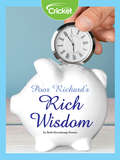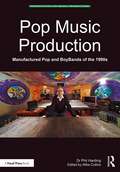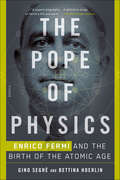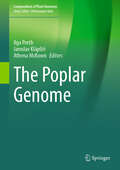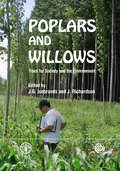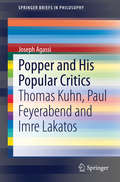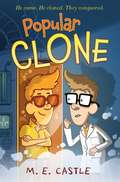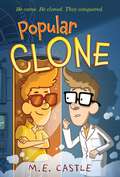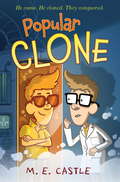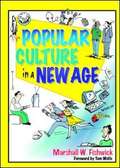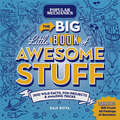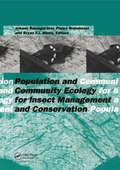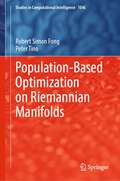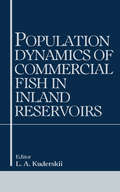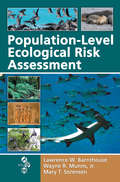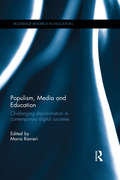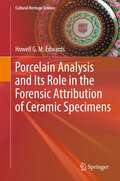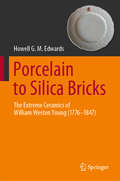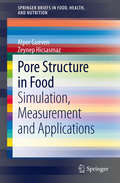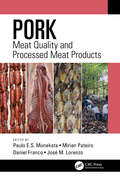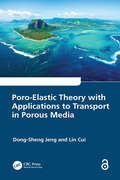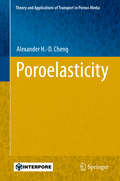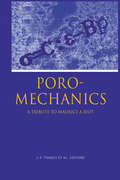- Table View
- List View
Poor Richard's Rich Wisdom
by Beth Haverkamp PowersIn Colonial America, many people owned two books: a bible and Poor Richard's Almanack, one of Ben Franklin's many inventions. Franklin included calendars, tidal charts, and riddles in his famous publication.
Pop Music Production: Manufactured Pop and BoyBands of the 1990s (Perspectives on Music Production)
by Phil HardingPop Music Production delves into academic depths around the culture, the business, the songwriting, and most importantly, the pop music production process. Phil Harding balances autobiographical discussion of events and relationships with academic analysis to offer poignant points on the value of pure popular music, particularly in relation to BoyBands and how creative pop production and songwriting teams function. Included here are practical resources, such as recording studio equipment lists, producer business deal examples and a 12-step mixing technique, where Harding expands upon previously released material to explain how ‘Stay Another Day’ by East 17 changed his approach to mixing forever. However, it is important to note that Harding almost downplays his involvement in his career. At no point is he center stage; he humbly discusses his position within the greater scheme of events. Pop Music Production offers cutting-edge analysis of a genre rarely afforded academic attention. This book is aimed at lecturers and students in the subject fields of Music Production, Audio Engineering, Music Technology, Popular Songwriting Studies and Popular Music Culture. It is suitable for all levels of study from FE students through to PhD researchers. Pop Music Production is also designed as a follow-up to Harding’s first book PWL from the Factory Floor (2010, Cherry Red Books), a memoir of his time working with 1980s pop production and songwriting powerhouse, Stock Aitken Waterman, at PWL Studios.
Pop Music Production: Manufactured Pop and BoyBands of the 1990s (ISSN)
by Phil HardingPop Music Production delves into academic depths around the culture, the business, the songwriting, and most importantly, the pop music production process. Phil Harding balances autobiographical discussion of events and relationships with academic analysis to offer poignant points on the value of pure popular music, particularly in relation to BoyBands and how creative pop production and songwriting teams function.Included here are practical resources, such as recording studio equipment lists, producer business deal examples and a 12-step mixing technique, where Harding expands upon previously released material to explain how ‘Stay Another Day’ by East 17 changed his approach to mixing forever. However, it is important to note that Harding almost downplays his involvement in his career. At no point is he center stage; he humbly discusses his position within the greater scheme of events. Pop Music Production offers cutting-edge analysis of a genre rarely afforded academic attention.This book is aimed at lecturers and students in the subject fields of Music Production, Audio Engineering, Music Technology, Popular Songwriting Studies and Popular Music Culture. It is suitable for all levels of study from FE students through to PhD researchers. Pop Music Production is also designed as a follow-up to Harding’s first book PWL from the Factory Floor (2010, Cherry Red Books), a memoir of his time working with 1980s pop production and songwriting powerhouse, Stock Aitken Waterman, at PWL Studios.
The Pope of Physics: Enrico Fermi and the Birth of the Atomic Age
by Gino Segrè Bettina HoerlinEnrico Fermi is unquestionably among the greats of the world's physicists, the most famous Italian scientist since Galileo. Called the Pope by his peers, he was regarded as infallible in his instincts and research. His discoveries changed our world; they led to weapons of mass destruction and conversely to life-saving medical interventions. This unassuming man struggled with issues relevant today, such as the threat of nuclear annihilation and the relationship of science to politics. Fleeing Fascism and anti-Semitism, Fermi became a leading figure in America's most secret project: building the atomic bomb. The last physicist who mastered all branches of the discipline, Fermi was a rare mixture of theorist and experimentalist. His rich legacy encompasses key advances in fields as diverse as comic rays, nuclear technology, and early computers. In their revealing book, The Pope of Physics, Gino Segré and Bettina Hoerlin bring this scientific visionary to life. An examination of the human dramas that touched Fermi’s life as well as a thrilling history of scientific innovation in the twentieth century, this is the comprehensive biography that Fermi deserves.
The Poplar Genome (Compendium of Plant Genomes)
by Ilga Porth Jaroslav Klápště Athena McKownThis book is the first comprehensive compilation of research on state‐of‐the-art genomics on the most advanced model tree species including genome assemblies, insights into genomic structural features and methylation patterns, whole‐genome resources used for population genomics and adaptation to climate, enabled breeding vs. classical genetics and traditional breeding, comparative genomics, and elucidations on functional genomics. The latest developments in the genomics of wood formation are particularly highlighted. Altogether, the book contains over 300 pages in over 15 chapters authored by globally reputed experts in the relevant fields of this tree crop’s genomics research. This book is useful for students, teachers, and scientists in academia and governmental or private tree improvement agencies or companies interested in genetics, pathology, entomology, physiology, molecular genetics and breeding, in vitro culture and genetic engineering, land restoration, and agroforestry solutions.
Poplars and Willows: Trees for Society and the Environment
by J G Isebrands J RichardsonPoplars and willows form an important component of forestry and agricultural systems, providing a wide range of wood and non-wood products. This book synthesizes research on poplars and willows, providing a practical worldwide overview and guide to their basic characteristics, cultivation and use, issues, problems and trends. Prominence is given to environmental benefits and the importance of poplar and willow cultivation in meeting the needs of people and communities, sustainable livelihoods, land use and development.
Poplars and Willows: Trees for Society and the Environment
by J. G. Isebrands J. RichardsonPoplars and willows form an important component of forestry and agricultural systems, providing a wide range of wood and non-wood products. This book synthesizes research on poplars and willows, providing a practical worldwide overview and guide to their basic characteristics, cultivation and use, issues, problems and trends. Prominence is given to environmental benefits and the importance of poplar and willow cultivation in meeting the needs of people and communities, sustainable livelihoods, land use and development.
Popper and His Popular Critics
by Joseph AgassiThis volume examines Popper's philosophy by analyzing the criticism of his most popular critics: Thomas Kuhn, Paul Feyerabend and Imre Lakatos. They all followed his rejection of the traditional view of science as inductive. Starting from the assumption that Hume's criticism of induction is valid, the book explores the central criticism and objections that these three critics have raised Their objections have met with great success, are significant and deserve paraphrase. One also may consider them reasonable protests against Popper's high standards rather than fundamental criticisms of his philosophy The book starts out with a preliminary discussion of some central background material and essentials of Popper's philosophy. It ends with nutshell representations of the philosophies of Popper. Kuhn, Feyerabend and Lakatos. The middle section of the book presents the connection between these philosophers and explains what their central ideas consists of, what the critical arguments are, how they presented them, and how valid they are. In the process, the author claims that Popper's popular critics used against him arguments that he had invented (and answered) without saying so. They differ from him mainly in that they demanded of all criticism that it should be constructive: do not stop believing a refuted theory unless there is a better alternative to it. Popper hardly ever discussed belief, delegating its study to psychology proper; he usually discussed only objective knowledge, knowledge that is public and thus open to public scrutiny.
Popular Clone
by M. E. Castle"Castle's debut, the first in a planned series, strikes just the right balance of humor and action and is sure to keep young readers turning the pages. Fisher's struggles to fit in, to relate to girls and to uncover and preserve his true self feel genuine, making him a misfit and unlikely hero worth rooting for. "-Kirkus Reviews Meet Fisher Bas: 12 years-old, growth-stunted, a geeky science genius, and son of the Nobel Prize-winning creators of the Bas-Hermaphrodite-Sea-Slug-Hypothesis. No surprise: Fisher isn't exactly the most popular kid in his middle-school, tormented daily by the beefy, overgrown goons he calls The Vikings. But he senses relief when he comes upon the idea of cloning himself--creating a second Fisher to go to school each day while he stays at home playing video games and eating cheetos with ketchup. It's an ingenious plan that works brilliantly, until Fisher's clone turns out to be more popular than him--and soon after gets clone-napped by the evil scientist Dr. Xander. Also available in simultaneous e-book edition (ISBN 978-1-60684-301-7).
Popular Clone (The Clone Chronicles #1)
by M. E. CastleMeet Fisher Bas: 12 years-old, growth-stunted, a geeky science genius, and son of the Nobel Prize-winning creators of the Bas-Hermaphrodite-Sea-Slug-Hypothesis. No surprise: Fisher isn't exactly the most popular kid in his middle-school, tormented daily by the beefy, overgrown goons he calls The Vikings. But he senses relief when he comes upon the idea of cloning himself—creating a second Fisher to go to school each day while he stays at home playing video games and eating cheetos with ketchup. It's an ingenious plan that works brilliantly, until Fisher's clone turns out to be more popular than him—and soon after gets clone-napped by the evil scientist Dr. Xander. Can Fischer save his clone in time, or will his whole plan be exposed?
Popular Clone: The Clone Chronicles #1
by M. E. Castle"Castle's debut, the first in a planned series, strikes just the right balance of humor and action and is sure to keep young readers turning the pages. Fisher's struggles to fit in, to relate to girls and to uncover and preserve his true self feel genuine, making him a misfit and unlikely hero worth rooting for."--Kirkus ReviewsMeet Fisher Bas: a 12-year-old, growth-stunted, geeky science genius who is the son of Nobel Prize -winning parents. Despite his outsized IQ, Fisher is far from the most popular kid in his middle school--he's actually tormented daily by the beefy, overgrown goons he calls the Vikings. Holed up in his home lab over a long weekend, Fisher uses his mother's revolutionary Advanced Growth Hormone to clone himself. Now Fisher Two can go to school each day while the real Fisher stays at home playing video games, eating Cheetos, and working on his latest inventions. It's an ingenious plan that works brilliantly . . . until Fisher's clone turns out to be more popular than him and then gets clone-napped by the evil scientist Dr. Xander. As his simple plan to literally avoid the toilet bowl of middle school collapses, Fisher's life gets even more complicated, and he must set out on an epic adventure to rescue his genetic counterpart.
Popular Culture in a New Age
by Marshall William FishwickFishwick (interdisciplinary studies, American studies, and popular culture studies, Virginia Tech) offers observations on popular culture in view of the changes brought about by the information revolution and the digital divide. Coverage hops about to address issues such as the millennium; distinctions between folk, fake, and pop; sacred symbols; the cult of celebrity; war; postmodern pop; and the concept of the global village, among other topics. Includes a couple of contributions by graduate students with similar snappy, stream-of-consciousness approaches.
Popular Mechanics The Big Little Book of Awesome Stuff: 300 Wild Facts, Fun Projects and Amazing Tricks
by Dan BovaDevelop new skills (card tricks!), make fun things (a water balloon launcher!) and learn crazy-cool facts with this hands-on activity book for ages 8 to 12Do you want to find out weird-but-true facts like how to safely enter a black hole or what to do if you meet a mythological monster? Interested in hitting a dizzying ping-pong trick shot or performing mind-blowing magic that&’ll amaze your friends? Think it&’d be fun to make the ultimate paper airplane or an insane water balloon launcher? If you answered yes to any of these questions, you&’ve come to the right book! The editors of Popular Mechanics put together this incredible, super-cool collection of did-you-know facts, super-fun projects and astounding skills for curious kids who like to discover stuff, build things, goof around a lot — and sometimes make a big mess in the process. (Don&’t tell your parents that last part!) On these totally non-boring pages you&’ll discover:Weird facts about pets…like the wild thing that happens when a dog shakes itself dry! The most incredible things ever built…like a 50-foot tall robot!Hilarious tricks and pranks to pull on your friends…if you dare! How to have a million-dollar idea and how to get on Jeopardy! Pro secrets for throwing a curveball and shooting a 3-pointer! How to contact aliens! Plus, even more awesome stuff! (More awesome than talking to aliens? Really? Yes, really!) Are you ready? Pick up this book and let the adventures begin!
Population and Community Ecology for Insect Management and Conservation
by Johann Baumgärtner Pietro Brandmayr Bryan Rj. ManlyOne of the themes of the 20th International Congress of Entomology held in Florence in August 1996 was Ecology and Population Dynamics, with papers presented on single species dynamics, population interactions, and community ecology. This book contains a selection of the papers that were presented, and gives a late-1990s picture of the latest research in this fast developing area.
Population-Based Optimization on Riemannian Manifolds (Studies in Computational Intelligence #1046)
by Robert Simon Fong Peter TinoManifold optimization is an emerging field of contemporary optimization that constructs efficient and robust algorithms by exploiting the specific geometrical structure of the search space. In our case the search space takes the form of a manifold. Manifold optimization methods mainly focus on adapting existing optimization methods from the usual “easy-to-deal-with” Euclidean search spaces to manifolds whose local geometry can be defined e.g. by a Riemannian structure. In this way the form of the adapted algorithms can stay unchanged. However, to accommodate the adaptation process, assumptions on the search space manifold often have to be made. In addition, the computations and estimations are confined by the local geometry.This book presents a framework for population-based optimization on Riemannian manifolds that overcomes both the constraints of locality and additional assumptions. Multi-modal, black-box manifold optimization problems on Riemannian manifolds can be tackled using zero-order stochastic optimization methods from a geometrical perspective, utilizing both the statistical geometry of the decision space and Riemannian geometry of the search space.This monograph presents in a self-contained manner both theoretical and empirical aspects of stochastic population-based optimization on abstract Riemannian manifolds.
Population Dynamics of Commercial Fish in Inland Reservoirs
by L.A. KuderskiiThis text analyzes the structure of fish populations in inland reservoirs, based on absolute values of their mass. The structure of population and its changes have been examined in seven fish species from small lakes, two from large lakes and seven from large reservoirs in plains. Special attention has been paid to the main indicator of the structure of population-correlation between the age of ichthyomass and mass maturation.
Population-Level Ecological Risk Assessment
by Lawrence W. Barnthouse Wayne R. Munns Jr. Mary T. SorensenMost ecological risk assessments consider the risk to individual organisms or organism-level attributes. From a management perspective, however, risks to population-level attributes and processes are often more relevant. Despite many published calls for population risk assessment and the abundance of available scientific research and technical tool
Populism, Media and Education: Challenging discrimination in contemporary digital societies (Routledge Research in Education)
by Maria RanieriBased on a major research project funded by the European Commission, Populism, Media and Education studies how discriminatory stereotypes are built online with a particular focus on right-wing populism. Globalization and migration have led to a new era of populism and racism in Western countries, rekindling traditional forms of discrimination through innovative means. New media platforms are being seen by populist organizations as a method to promote hate speech and unprecedented forms of proselytism. Race, gender, disability and sexual orientation are all being used to discriminate and young people are the preferred target for populist organizations and movements. This book examines how media education can help to deconstruct such hate speech and promote young people’s full participation in media-saturated societies. Drawing on rich examples from Austria, Belgium, Bulgaria, France, Italy, Slovenia, and the UK - countries characterized by different political and cultural contexts – Populism, Media and Education addresses key questions about the meaning of new populism, the nature of e-engagement, and the role of education and citizenship in the digital century. With its international and interdisciplinary approach, this book is essential reading for academics and students in the areas of education, media studies, sociology, cultural studies, political sciences, discrimination and gender studies.
Porcelain Analysis and Its Role in the Forensic Attribution of Ceramic Specimens (Cultural Heritage Science)
by Howell G. EdwardsThe material for this book arose from the author’s research into porcelains over many years, as a collector in appreciation of their artistic beauty , as an analytical chemist in the scientific interrogation of their body paste, enamel pigments and glaze compositions, and as a ceramic historian in the assessment of their manufactory foundations and their correlation with available documentation relating to their recipes and formulations. A discussion of the role of analysis in the framework of a holistic assessment of artworks and specifically the composition of porcelain, namely hard paste, soft paste, phosphatic, bone china and magnesian, is followed by its growth from its beginnings in China to its importation into Europe in the 16th Century. A survey of European porcelain manufactories in the 17th and 18th Centuries is followed by a description of the raw materials, minerals and recipes for porcelain manufacture and details of the chemistry of the high temperature firing processes involved therein. The historical backgrounds to several important European factories are considered, highlighting the imperfections in the written record that have been perpetuated through the ages. The analytical chemical information derived from the interrogation of specimens, from fragments, shards or perfect finished items, is reviewed and operational protocols established for the identification of a factory output from the data presented. Several case studies are examined in detail across several porcelain manufactories to indicate the role adopted by modern analytical science, with information provided at the quantitative elemental oxide and qualitative molecular spectroscopic levels, where applicable. The attribution of a specimen to a particular factory is either supported thereby or in some cases a potential reassessment of an earlier attribution is indicated. Overall, the information provided by analytical chemical data is seen to be extremely useful for porcelain identification and for its potential attribution in the context of a holistic forensic evaluation of hitherto unknown porcelain exemplars of questionable factory origins.
Porcelain to Silica Bricks: The Extreme Ceramics of William Weston Young (1776-1847)
by Howell G.M. EdwardsThe title of this book describes the two extremes of ceramic invention from aesthetically beautiful and decorative works of art that graced the tables of the aristocracy to the functional silica brick that lined the smelting furnaces of industrialised nations in the 19th century designed to produce iron, copper and glass. Both of these ceramics are linked to one man, William Weston Young (1776-1847) and with his contemporaries both of these ceramic extremes became world leaders in their own right. The book traces the history of Young and his ambitions, his interactions with numerous associates and the influence these ceramics attained in 19th century society. The book provides a sequel to the two preceding texts on Nantgarw and Swansea porcelains (also published by Springer), which cover one extreme and extends the discourse onto the other extreme, which until now has been relatively ignored despite its scientific and engineering importance. The trilogy has now therefore been completed. This book examines the historical documentation along with scientific analytical data from the last 100 years up to the present in a novel holistic forensic approach.It will be of interest to porcelain collectors, ceramics analysts, museum ceramic curators, ceramic historians, analytical scientists, cultural heritage preservation, industrial archaeologists and industrial museums.
Pore Structure in Food: Simulation, Measurement and Applications
by Zeynep Hicsasmaz Alper GuevenThe pore structure of foods directly affects the success of such food processes as drying, puffing, freeze-drying, and rehydration. Consequently, the pore structure of foods determines what types of food processes will work best with a particular food. This Brief will first discuss in depth the need to correctly measure the pore structure of foods and then will identify and describe in detail the current methods available to measure food porosity. Finally, it will review the applications of these various methods.
Pork: Meat Quality and Processed Meat Products
by Paulo E. S. MunekataThe processing of pork is a common technological practice that modifies the taste, flavor, texture and color of raw pork meat. Due to pork’s accessible price and versatility, the manufacture of pork products to offer a variety of options to consumers is an important strategy of the meat industries in this sector to improve profits and expand into new markets at the local, regional and international levels. The diversity of pork products reflects the diversity and history of many local cultures around the world, as well as a growing interest in preserving traditional processing practices. Pork: Meat Quality and Processed Meat Products delves into the various kinds of pork and the methods used to prepare it for consumption, including fresh meat products, fermented sausages, dry-cured products, blood sausages and cooked sausages. Each category starts with a specific raw material (entire cut vs. minced pork meat) to which is added a unique combination of ingredients (e.g., sodium chloride, starter cultures, blood, seasoning and spices). The method of processing (such as salting, drying, thermal processing and fermenting) takes consumer tastes and storage needs into account, as well as how each product will be consumed (cooked, sliced, spread and as an ingredient in other dishes, for instance). Consequently, a wide range of products made from pork are currently being produced worldwide. Added to this is the increasing importance of ingredients and health factors to consumers; the resulting demand for products that address specific health concerns is having a significant impact on research into and the production of pork meat products. Key Features: Comprehensively presents and discusses the wealth of information about pork products Includes specific details about the processing, quality of final products and innovation in the industry Presents innovative, health-oriented approaches to making traditional and commercial pork products Discusses healthier pork meat products that address consumer trends and government recommendations The production of health-oriented pork products is an emerging and promising investigation area with a direct impact on the currect market for meat products.
Poro-Elastic Theory with Applications to Transport in Porous Media
by Dong-Sheng Jeng Lin CuiThis book treats the subject of porous flow and its applications in three engineering and scientific problems. The first major part of the book is devoted to solute transport in unsaturated porous media. Dynamic hydraulic conductivity and degree of saturation associate with pore pressures are also included in the consolidation-induced solute transport process. The second part of this book focuses on tidal dynamics in coastal aquifers, including shallow water expansion for sloping beaches, two-dimensional problem in estuarine zone and leaky confined aquifers. The final part of the book summarizes the recent development of porous model in the field of liquefaction around marine infrastructures including fundamental mechanisms of momentary and residual seabed liquefaction, two-dimensional and three-dimensional porous models for fluid-seabed interactions around breakwaters, pipelines and piled foundations in marine environments. The authors’ aim is to describe in detail the applications of porous models for several engineering problems. This book will provide academic researchers and industry an overview of recent development in the field of porous models and the applications. The Open Access version of this book, available at http://www.taylorfrancis.com, has been made available under a Creative Commons Non Commercial-No Derivatives (CC-BY-NC-ND) 4.0 license. Funded by Qingdao University Technology, China
Poroelasticity
by Alexander H.-D. ChengThis book treats the mechanics of porous materials infiltrated with a fluid (poromechanics), focussing on its linear theory (poroelasticity). Porous materials from inanimate bodies such as sand, soil and rock, living bodies such as plant tissue, animal flesh, or man-made materials can look very different due to their different origins, but as readers will see, the underlying physical principles governing their mechanical behaviors can be the same, making this work relevant not only to engineers but also to scientists across other scientific disciplines. Readers will find discussions of physical phenomena including soil consolidation, land subsidence, slope stability, borehole failure, hydraulic fracturing, water wave and seabed interaction, earthquake aftershock, fluid injection induced seismicity and heat induced pore pressure spalling as well as discussions of seismoelectric and seismoelectromagnetic effects. The work also explores the biomechanics of cartilage, bone and blood vessels. Chapters present theory using an intuitive, phenomenological approach at the bulk continuum level, and a thermodynamics-based variational energy approach at the micromechanical level. The physical mechanisms covered extend from the quasi-static theory of poroelasticity to poroelastodynamics, poroviscoelasticity, porothermoelasticity, and porochemoelasticity. Closed form analytical solutions are derived in details. This book provides an excellent introduction to linear poroelasticity and is especially relevant to those involved in civil engineering, petroleum and reservoir engineering, rock mechanics, hydrology, geophysics, and biomechanics.
Poromechanics: Proceedings of the 1st Biot conference
by J. F. ThimusThis text features 105 papers dealing with the fundamentals and the applications of poromechanics from the Biot conference of 1998, held in Louvain-la-Neuve. Topics include: wave propogation; numerical modelling; identification of poromechanical parameters; and constitutive modelling.
